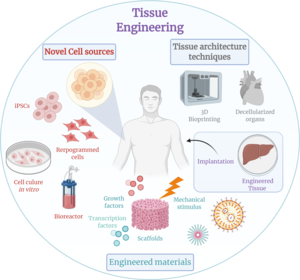
Tissue engineering is a biomedical engineering discipline that uses a combination of cells, engineering, materials methods, and suitable biochemical and physicochemical factors to restore, maintain, improve, or replace different types of biological tissues. Tissue engineering often involves the use of cells placed on tissue scaffolds in the formation of new viable tissue for a medical purpose, but is not limited to applications involving cells and tissue scaffolds. While it was once categorized as a sub-field of biomaterials, having grown in scope and importance, it can be considered as a field of its own.[1]
While most definitions of tissue engineering cover a broad range of applications, in practice, the term is closely associated with applications that repair or replace portions of or whole tissues (i.e. organs, bone, cartilage,[2] blood vessels, bladder, skin, muscle etc.). Often, the tissues involved require certain mechanical and structural properties for proper functioning. The term has also been applied to efforts to perform specific biochemical functions using cells within an artificially-created support system (e.g. an artificial pancreas, or a bio artificial liver). The term regenerative medicine is often used synonymously with tissue engineering, although those involved in regenerative medicine place more emphasis on the use of stem cells or progenitor cells to produce tissues.
- ^ Kim, Yu Seon; Smoak, Mollie M.; Melchiorri, Anthony J.; Mikos, Antonios G. (1 January 2019). "An Overview of the Tissue Engineering Market in the United States from 2011 to 2018". Tissue Engineering. Part A. 25 (1–2): 1–8. doi:10.1089/ten.tea.2018.0138. ISSN 1937-3341. PMC 6352506. PMID 30027831.
- ^ Whitney GA, Jayaraman K, Dennis JE, Mansour JM (February 2017). "Scaffold-free cartilage subjected to frictional shear stress demonstrates damage by cracking and surface peeling". Journal of Tissue Engineering and Regenerative Medicine. 11 (2): 412–24. doi:10.1002/term.1925. PMC 4641823. PMID 24965503.